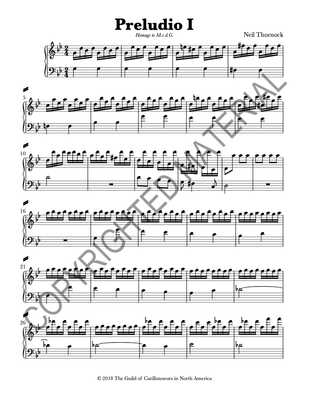
[PDF] Eleven Preludios (Thornock)
Program notes
Eleven Preludios is a musical homage to the Flemish carillonneur and composer Matthias Vanden Gheyn (1721–1785). Vanden Gheyn's series of eleven "preludios," along with several miscellaneous shorter pieces, are among the earliest preserved pieces written expressly for the carillon. In his writing, Vanden Gheyn employed several idioms normally associated with violin music; specifically, the use of echoes (where a short passage of music is repeated, but more softly the second time) and of pedal points (where a moving line of notes alternates with a stationary repeated note). Another characteristic was the frequent use of fully-diminished seventh chord figurations, which take on a special power with the minor-third overtones of carillon bells. The use of the diminished seventh is key to the argument that Vanden Gheyn's preludes were written for carillon specifically, and not for keyboard generally. Neil Thornock has taken numerous elements from the Vanden Gheyn pieces, and expanded some musical idioms, often adding quirky, somewhat humorous (some might say anachronistic) touches. For an audience unfamiliar with Vanden Gheyn's music, it might be interesting to hear some of his works, followed by some of these delightful pieces.
In his own series of preludes, Thornock has used idioms from Vanden Gheyn's music in a wide variety of ways, while making freer changes in harmony than one would find in baroque music. Some of them explore more lyric writing than the original preludes had. Thornock intentionally wrote these pieces to fit within the 3 1/2-octave (42 bell) range, though on a few occasions, he briefly exceeds that range.
- Preludio I uses the broken-chord figurations and occasional passages with scale patterns in parallel tenths between the upper voice and the bass voice. Occasionally, the running sixteenth-notes are interrupted by passages of eighth-note chords, reminiscent of Vanden Gheyn's shorthand method of writing broken chord patterns (which should not be played as literal block chords). Along the way, the composer makes some surprising turns in harmony.
- In Preludio II, Thornock adapted the figurations to fit a 3/4 time signature (which Vanden Gheyn didn't use in his preludes). Thornock does use several diminished-chord patterns along the way (an important feature of Vanden Gheyn's writing, since the minor thirds are so effective on the bells).
- Preludio III opens with a melody reminiscent of Italian Baroque violin music (in particular, one of Vivaldi's violin concerti), along with many ascending scales, diminished-seventh arpeggios, and broken octave figures.
- Preludio IV features dramatic fanfare-like arpeggios, many diminished-chord figurations, and near the end, a rapid, virtuoso "cadenza."
- Preludio V is closely related to Vanden Gheyn's third prelude, including being in the same C-major key, but also using very similar descending broken-chord figurations with each note repeated. Also, both pieces include some brief triplet figures and a virtuoso cadenza at the end.
- Preludio VI is a more lyric piece in 6/8 time. The harmonies gently shift, with much chromaticism, almost sentimental at times.
- Preludio VII, in 9/8 time, is less baroque in character, and more akin to virtuosic romantic-era piano music. It also requires considerable virtuosity and agility from the carillonneur, including some quite tricky hand-foot coordination in some of the arpeggio figurations. Of the entire set, Preludio VII is the least related to the preludes of Vanden Gheyn.
- Preludio VIII probably has the most obvious relationship with a specific Vanden Gheyn prelude, specifically the fifth. The beginning is almost an inversion of the Vanden Gheyn, with ascending broken chords and descending scales. In most of these pieces, Thornock expounds on each musical idea at more length than Vanden Gheyn did. Many of the rhythmic patterns from the Vanden Gheyn are present (though used differently) in this piece. The final section, however, is considerably more chromatic than anything from Vanden Gheyn's time.
- The joyous Preludio IX uses straightforward broken-chord patterns, with its often-subtle shifts in harmonies that make it reminiscent of an etude for guitar.
- Preludio X is slower, with baroque-style undulating chord figurations not found in Vanden Gheyn's music, and harmonic twists that suggest an impressionistic style of writing.
- Like the Vanden Gheyn pieces, the eleventh prelude is entitled "Coucou" and is full of "cuckoo" figurations. In Thornock's version, the cuckoo figurations are mostly minor thirds, often tossed around from lower to higher ranges, and moving through "functional harmonic progressions," typical for baroque music, but rarely used by Vanden Gheyn. All these minor third figures quite naturally grow into larger diminished chord patterns.
—The GCNA
![[PDF] Eleven Preludios (Thornock) [PDF] Eleven Preludios (Thornock)](https://d2j6dbq0eux0bg.cloudfront.net/images/9481258/4383256649.png)
